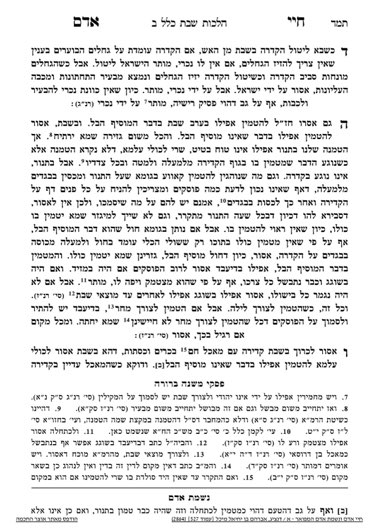We are beginning siman 5, where the Chayei Adam will discuss hatmana, insulating food which is not on the fire. Although theoretically this could apply on Shabbos, the primary issue is when it occurs on erev Shabbos. Therefore, the Chayei Adam discusses this halacha primarily over here, although he returns to it later, when discussing the halachos of cooking on Shabbos. In that sense, it is understandable why the Chayei Adam places these halachos over here, and leaves chazarah for later, because it only applies on Shabbos itself. However, the Shulchan Aruch discusses shehiyah and chazarah together, but discusses hatmana separately in a later siman. The logic of the presentation of the Shulchan Aruch is that the halachos of shehiyah and chazarah have similar characteristics, to the point that there is a machlokes whether the first mishnah in the third perek of maseches Shabbos is discussing shehiyah or chazarah.
When it comes to hatmana, Chazal differentiate between two different types of materials: materials which insulate but do not increase the heat, and materials which tend to add heat. We know that certain biocomposts can generate heat due to the breakdown of chemicals and the bacteria which feed on it. Chazal understood that there are certain materials which either inherently generate heat, or which are so good at reflecting the heat of the food they are considered as generating heat. These materials are known in halacha as mosif hevel. There are certain materials which do not generate heat, but only maintain and insulate the heat currently present. These materials are known as maamid hevel.
Chazal prohibit performing hatmana with something which is mosif hevel even from before Shabbos. Something which is only maamid hevel may be used to perform hatmana before Shabbos. As a reminder, we are discussing items which are not on the fire; if they are on the fire, it would fall under shehiyah or chazarah.
An example of hatmana would be taking a pot of soup which just came off of the fire and wrapping it in a blanket or towel until it is served. The blanket is an example of maamid hevel, so if it is wrapped before Shabbos it is muttar, and if it is wrapped after Shabbos has started, it is assur. If one were to insulate the pot while it is on a blech, it would be assur even before Shabbos, because the fact that there is a heat source present makes the blanket into a mosif hevel.
Chazal prohibited performing hatmana on Shabbos itself. Thus, in our scenario, if one removed the soup from the fire on Shabbos itself, and then wrapped it in a towel, it is assur. One may be able to return the pot to the fire under certain circumstances, which we will clarify, but one cannot transfer the pot from the fire into a state of hatmana.
Summary
-
Hatmana refers to insulating food not on the fire.
-
A davar mosif hevel cannot be used for hatmana even before Shabbos
-
A davar maamid hevel can be used for hatmana before Shabbos, but not on Shabbos itself.



